On the same day that their senior squad suffered a 3-0 defeat in the semi-final of the 2019/20 UEFA Champions League at the hands of Bundesliga side Bayern Munich, Olympique Lyon’s U19s suffered defeat in the quarter-final of the 2019/20 UEFA Youth League in a thrilling clash with Red Bull Salzburg’s U19s that saw the Austrian side come away with a 4-3 victory.
This was a game in which both sides exhibited a large degree of flexibility in their tactics. Both teams possess wide skill sets and plenty of quality in the technical, physical and mental aspects of the game.
In this tactical analysis piece, we will examine how both Olympique Lyon and Red Bull Salzburg approached this game from a tactical perspective. We will look at how both teams lined up and we will attempt to explain the tactics that both teams predominantly deployed during this contest, and how those respective tactical set-ups influenced this game.
Lineups and formations
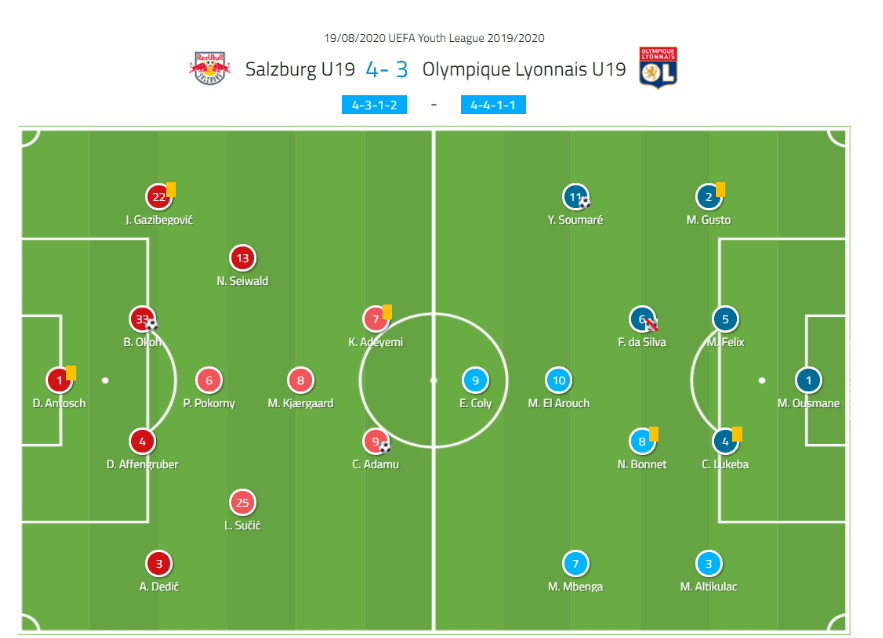
Firstly, Bo Svensson lined his Salzburg side up in a 4-diamond-2 shape for this quarter-final clash.
Daniel Antosch started between the sticks for the Austrian side and he played behind a back four featuring Amar Dedić at right-back, Jusuf Gazibegović at left-back and the central defensive pairing of David Affengruber and Bryan Okoh.
Peter Pokorny started at the base of midfield, while Luka Sučić and Nicolas Seiwald played ahead of him on either side of central midfield. Meanwhile, Maurits Kjærgaard started in the ‘10’ position and the attacking duo of Chukwubuike Adamu and Karim Adeyemi started up front for Salzburg.
As for Lyon, their shape varied between a 4-1-4-1 formation and a 4-4-2 formation throughout this contest, however, we believe that they lined up in a 4-1-4-1 shape for the majority of the game.
Mamadou Kévin Ousmane started in goal for Les Gones, while Malo Gusto and Melih Altikulac started this fixture at right and left-back, respectively, while Lyon boss Eric Hély went with a centre-back duo of Marley Felix and Castello Lukeba for this fixture.
Yaya Soumaré started at right-wing, Modeste Duku Mbenga started at left-wing, Noam Bonnet started in the holding midfield position, while Florent da Silva and Mohamed El Arouch occupied the remaining two places in Lyon’s midfield versus Salzburg. Meanwhile, El Hadj Coly started up front for Les Gones in this fixture.
Olympique Lyon out of possession
We will focus on both of these two teams’ tactics out of possession to kick off this tactical analysis, starting with Hély’s side.
While the image in the previous section suggests that Lyon lined up in a 4-4-1-1 formation in this game, their formation much more closely resembled a 4-1-4-1 shape, with Bonnet typically performing the defensive midfield role, sitting between the two lines of four within this system.
However, Les Gones weren’t particularly strict about which midfielder filled that role, as long as the overall shape was intact and as a result, da Silva dropped into the holding midfield position at times, while Bonnet became a more advanced number ‘8’ on those occasions.
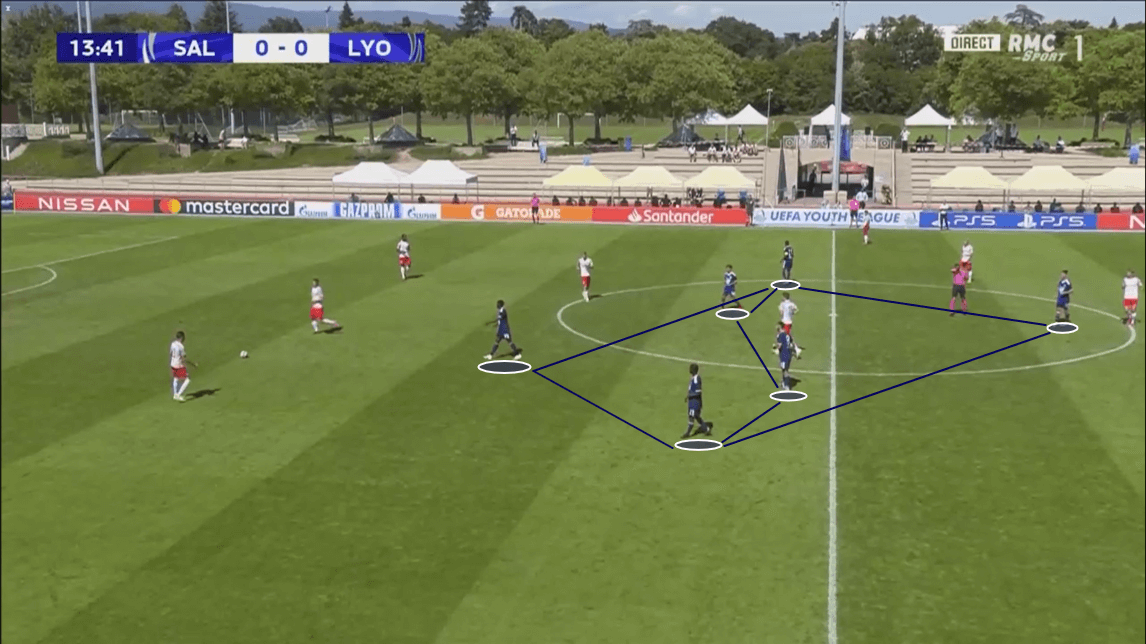
This image above provides us with an example of how Lyon set up defensively for this clash with Salzburg. They generally utilised a position oriented zonal marking system off the ball throughout this contest and while Salzburg attempted to build out from the back, the French side became very horizontally compact, essentially cutting off access to the centre of the pitch for Salzburg and forcing them to either play over them or play around them.
Additionally, the positioning of one player between the two lines of four prevented the opposition from exploiting space between those two lines.
While they showed glimpses of aggression off the ball during the game, Lyon generally defended quite passively. They were happy enough to sit off the Salzburg backline when they had possession of the ball and they didn’t usually attempt to force possession away from them. Instead, they focused on cutting off the Austrian side’s options for ball progression and made it difficult for them to play through the midfield.
This often forced Salzburg to play the ball out wide to an advancing full-back, and that pass triggered a more aggressive press from Lyon at times in this game. Additionally, another option that Salzburg often took up in this contest in order to build past Lyon’s press was to play the ball long and they caused Lyon plenty of trouble via long-balls in this fixture, as we will discuss at greater length elsewhere in this tactical analysis piece.
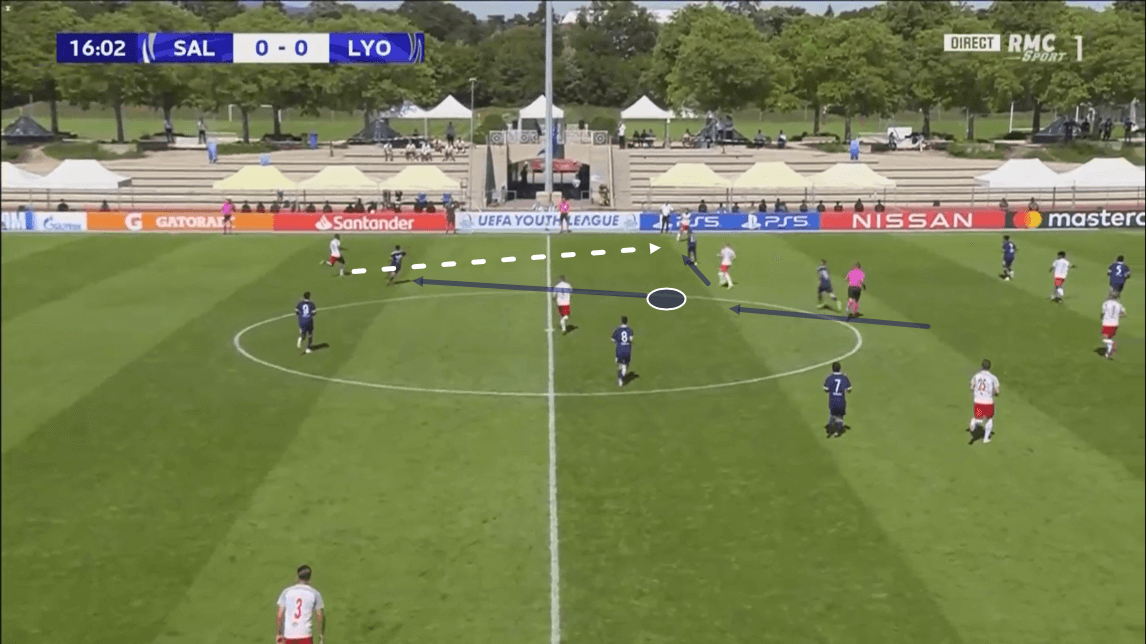
This next image above shows us an example of one occasion when Lyon midfielder El Arouch vacated his position in the line of four in central midfield in order to press more aggressively.
The midfielder performed well in this role during the game and helped to force turnovers on a couple of occasions thanks to his quickness and his reading of the game, as he displayed plenty of intelligence to decide when and when not to press more aggressively, like this.
On occasions when El Arouch did vacate his position to press higher up the pitch, Lyon’s holding midfielder, usually Bonnet, would push up from his position and take the 16-year-old’s place in central midfield, thus creating a 4-4-2 shape. While Les Gones generally maintained their 4-1-4-1 shape throughout this contest, they displayed some variety in their defensive shape to effectively switch to a 4-4-2 like this.
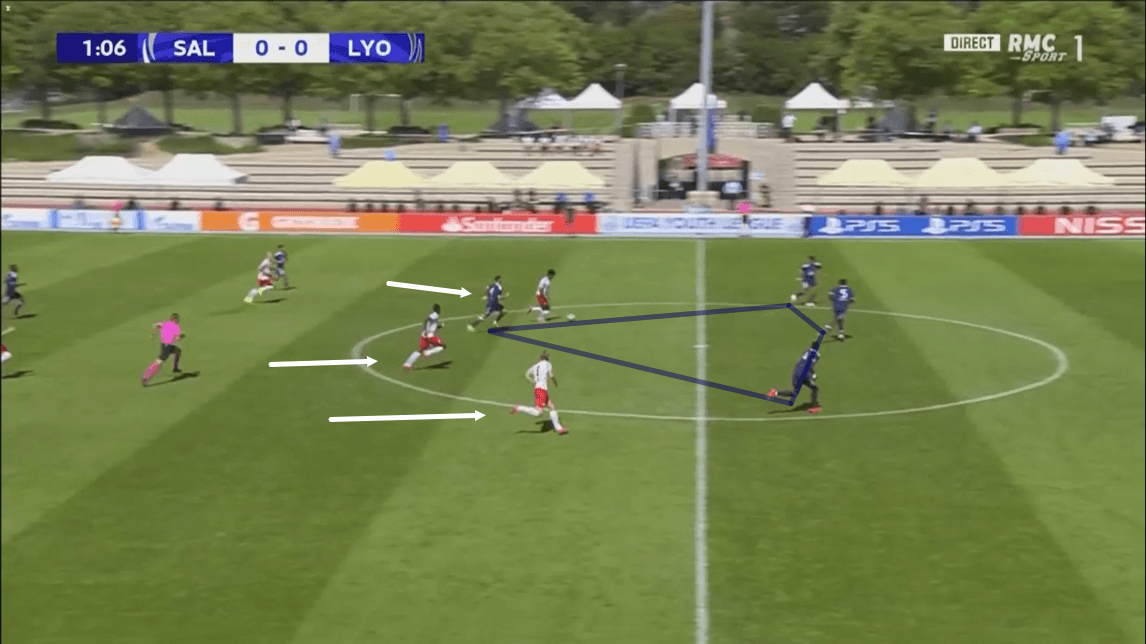
This next image shows us how Lyon looked during the transition to defence in this fixture. As we will discuss at greater length later on in this tactical analysis piece, one of Les Gones’ full-backs typically departed from the defensive line to join the attack when in possession of the ball.
However, as we can see in the image above, when one full-back went forward the other remained in the defensive line alongside the centre-backs and tucked inside, forming a back three.
Additionally, the holding midfielder would also stay back, so this created something of a ‘3-1’ shape at the base of the team for Lyon when in possession of the ball.
When Les Gones were attacking the opposition penalty box, these four players had to be prepared to deal with counter-attacks and they managed to do so effectively here.
As we can see, the backline of three remained quite narrow and orientated themselves in quite close proximity to one another. They effectively slowed down Salzburg’s counter-attack when it reached them via their positioning and patient but effective defending. This then allowed the holding midfielder to catch the ball-carrier on this occasion, preventing this counter-attack from causing too much harm to Les Gones.
Red Bull Salzburg out of possession
Lyon’s PPDA (Opponent passes per defensive action in opponent’s final 60% of the pitch) for this quarter-final clash with Salzburg was 10.7, however, the Austrian side had a PPDA of just 6.4 for this game. This statistic provides us with a measure of each team’s pressing intensity in this fixture and these specific stats tell us that Salzburg deployed a more intense press than Lyon did, which was also evident when viewing the game.
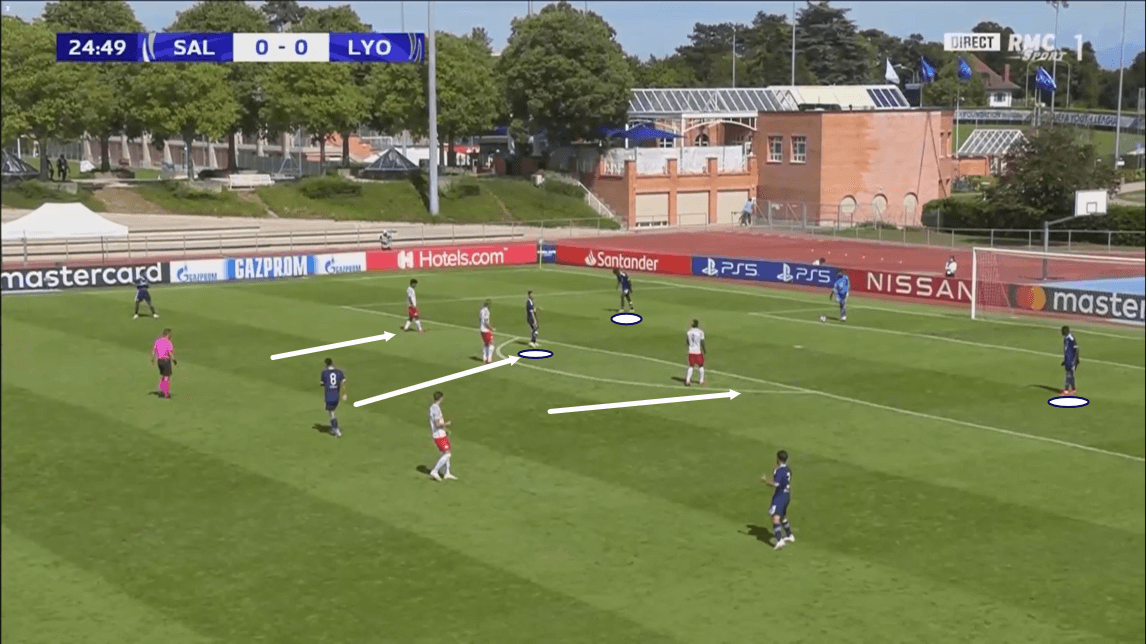
The above image provides us with an example of how Salzburg’s shape looked out of possession during an opposition goal kick. Both of the Austrian side’s strikers maintained access to Lyon’s central defensive pairing during the goal-kicks, and during the build-up in general, while Salzburg’s attacking midfielder stuck tight to Lyon’s holding midfielder.
The French side’s holding midfielder would even drop as deep as the central defenders at times, but this wouldn’t stop the attacking midfielder from following him all the way. This would quite often create a flat front line of three for Salzburg out of possession.
None of the rest of Lyon’s players generally dropped deep to collect a short pass from the goalkeeper and as a result, with all three of the goalkeeper’s safe, short passing options effectively marked out of the game, Ousmane often had to rely on long-balls and balls out to the full-backs during the early stage of the build-up.
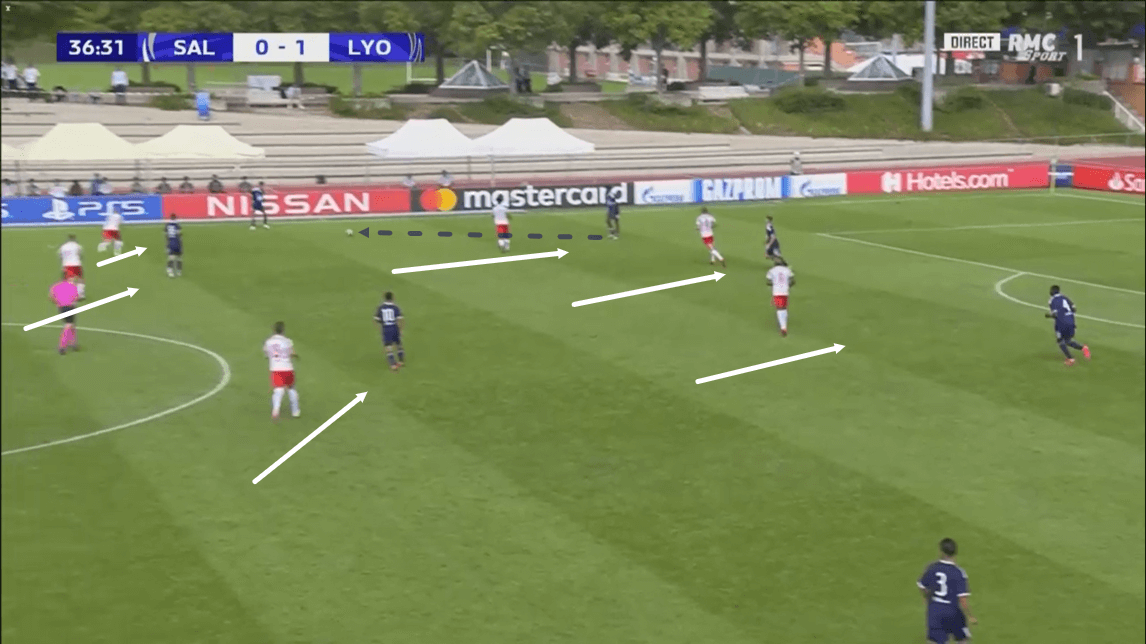
Furthermore, when the centre-backs did receive a short pass from the goalkeeper early on during the build-up, they too often struggled to play through the centre due to the intense and well-organised nature of Salzburg’s press. As a result, they also often had to play the ball out to the full-backs, as we can see in the image above, which provides us with another example of Salzburg’s high press in action with their front three off the ball quite visible, as well as their two wide central midfielders who can be seen marking Lyon’s two more advanced central midfielders tight.
However, as Lyon play the ball out to their right-back here, we can also see that Salzburg’s left-back is approaching in an attempt to quickly close him down and prevent Les Gones from building out from the back via this player.
The Austrian side generally seemed happy enough for Lyon to play this pass from either the goalkeeper or one of the centre-backs to the full-back, as they could comfortably continue to deploy an aggressive press once the ball was played into this position, using the sideline as, essentially, an additional defender, to make it difficult for Les Gones to play out through this player.
Salzburg forced plenty of turnovers in this manner versus Lyon, particularly during the first half.
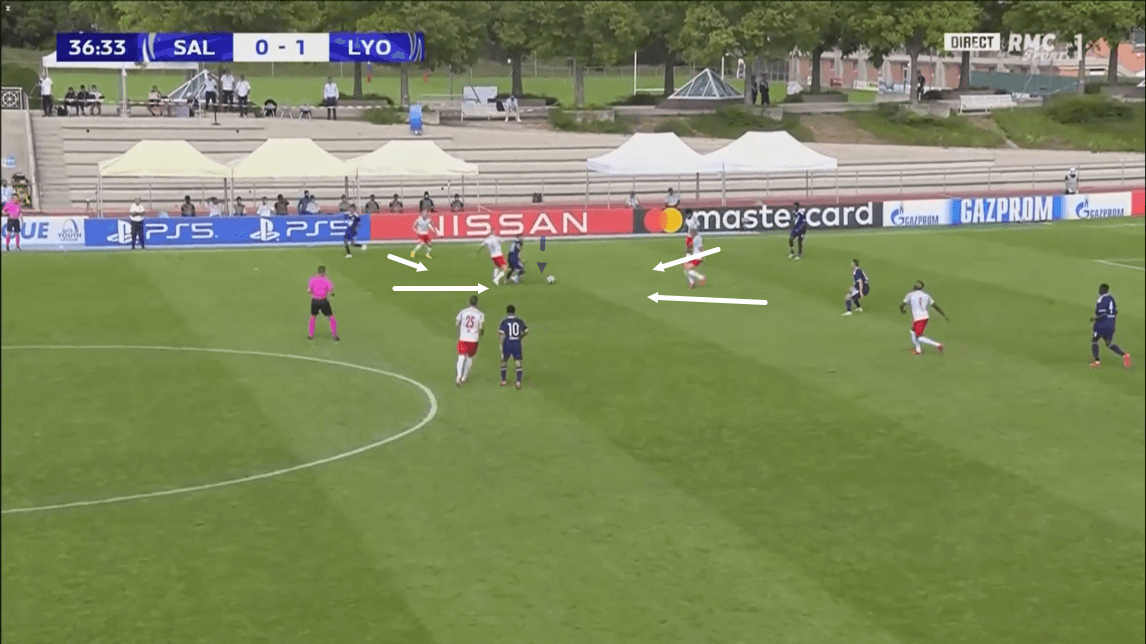
As this particular passage of play moves on, we see that the Lyon right-back actually managed to retain possession for his side, despite the Salzburg player’s aggressive press, as he played the ball into the right central midfielder, who we noted was also being tightly marked at this point in time.
However, due to the central dominance that they had in this game due to their diamond midfield and especially in this area of the pitch, due to their high press, Salzburg were effective at subsequently preventing the Lyon midfielder from advancing the play any further.
This Lyon midfielder does do quite well to retain possession here, however, as he evades the challenges from Salzburg players and lays the ball back to one of Les Gones’ defenders, so Lyon may not have suffered the worst consequence for their struggle to build past Salzburg’s press on this occasion, though they were made to pay more severely at other stages in this game.
During the transition to defence, and when the ball was still in Lyon’s half, Salzburg tended to deploy a counter-press in an attempt to win the ball back immediately after turning over possession. However, as Lyon progressed into the Austrian side’s half, they then seemed to focus more on getting men behind the ball before committing to a more aggressive press on the opposition.
In deeper areas, Salzburg generally defended in an aggressive manner, similarly to how they defended high up the pitch. They played with a high defensive line and their central defenders attempted plenty of interceptions to try and win the ball back, some of which came off and some of which failed and resulted in some clear-cut chances for Lyon.
Olympique Lyon in possession
Lyon retained 51% of the possession in this game to Salzburg’s 49%. However, while Les Gones did keep slightly more of the possession, neither of these two teams played with a heavily-possession-based style in Wednesday’s UEFA Youth League quarter-final clash.
Lyon had a pass accuracy of just 72% versus Salzburg, while the Austrian side played just 73% of their passes accurately in this game.
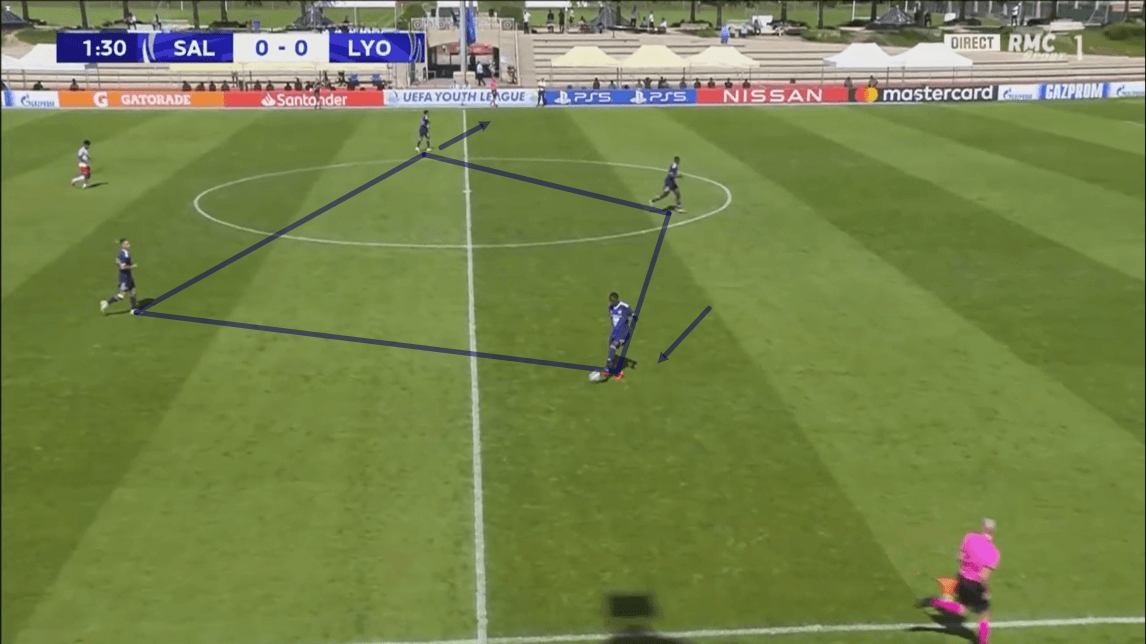
We took a look at how Lyon played from goal-kicks during the previous section looking at Salzburg’s tactics out of possession, however, the image above provides us with an example of how Lyon shaped up just after regaining possession of the ball slightly higher up the pitch.
This shape is very similar to the shape that we saw Les Gones lining up in when analysing their transition to defence, and that is because this image is taken just after the ball was cleared following a Lyon attack.
While Salzburg dealt with the Lyon attack effectively, Les Gones were able to quickly get into position to rebuild.
The only real difference between the shape that we see them utilising in possession of the ball here, and the shape that we saw them lining up in when trying to defend against an opposition counter-attack earlier on, is the spacing between the players. As soon as Lyon win possession here, the two defenders that are positioned widest shift further out wide, while the central centre-back also moves to a slightly deeper position. This creates more space between the players and gives the opposition a larger area of the pitch to worry about when defending, in addition to giving the defender in possession of the ball more options.
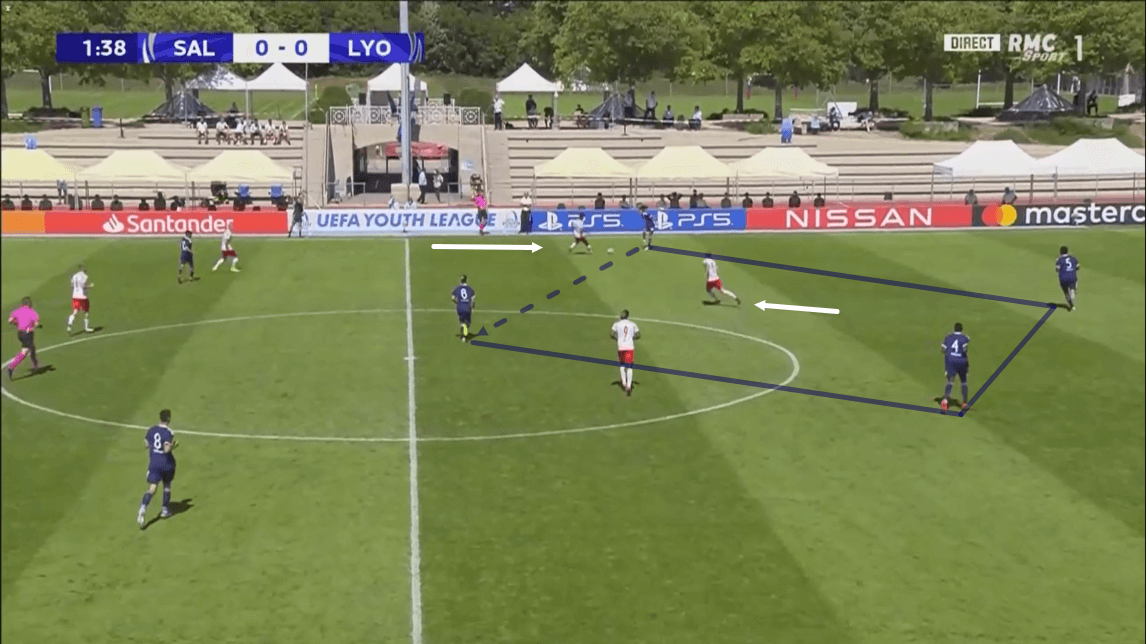
As this particular passage of play moves on, Lyon played around with the ball in their own half for a short bit of time before Salzburg players arrive in the opposition half and begin to press aggressively. On this occasion, Lyon seemingly welcomed that press as they had plenty of time to get themselves into position to play around the oncoming opposition players, which is exactly what they do.
When providing analysis of Salzburg out of possession, we looked at a passage of play in which Lyon’s right-back played the ball inside to the central midfielder and here, similarly, the right-back played a diagonal ball inside to the holding midfielder. The recipient ultimately wastes possession, however, as he attempts to play a long-ball to a more advanced teammate but the pass goes wayward.
However, it’s clear that Lyon placed a large emphasis on playing through the centre where possible in the first half of this game and considering that this last pass was effective at beating Salzburg’s first line of pressure, we believe it’s understandable why they felt this strategy was a good one to deploy.
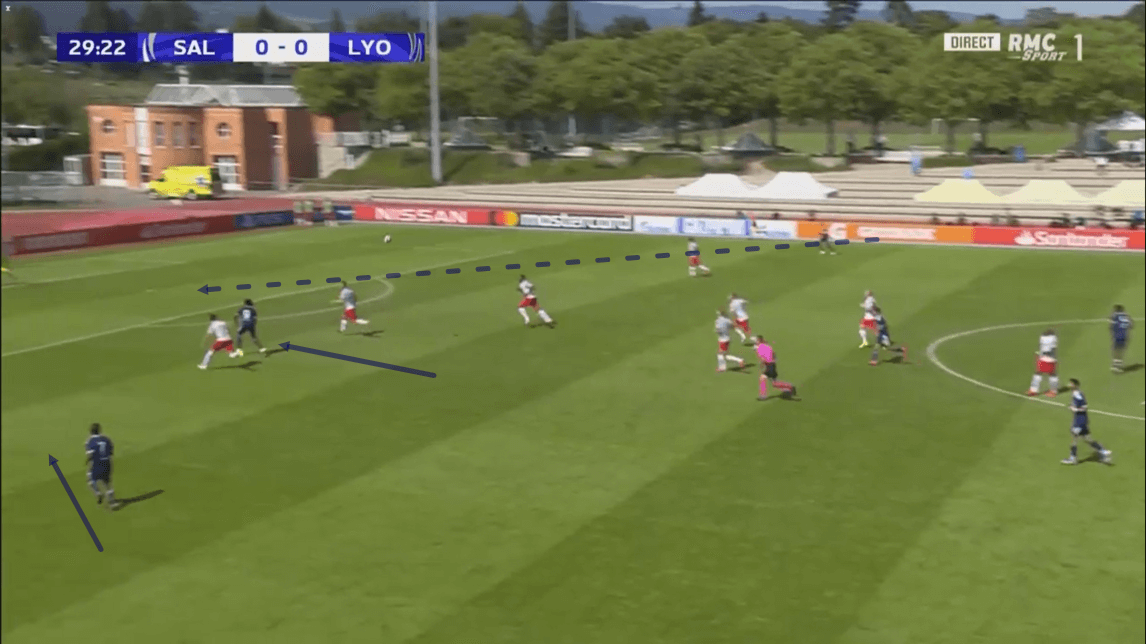
Lyon were comfortable with playing long-balls in this game and they caused the opposition defence plenty of problems via long-balls and aerial duels. Les Gones had plenty of pace and power in attack throughout this game and Salzburg’s defenders struggled to cope with the Lyon attackers’ physical qualities throughout this game.
The French side exploited these struggles via long-balls over the top and we can see an example of one such occasion when they did this in the image above.
Here, we can see that a ball is coming over the top for the Lyon attacker to chase, as he did on a variety of occasions throughout this contest. On this occasion, however, when the subsequent aerial duel occurs inside the penalty area, the Salzburg defender manages to get his head on the ball over the Lyon man.
However, even when they successfully won the aerial duel, Salzburg struggled to really deal with the threat and the defender only heads the ball away as far as the edge of the box where it quickly falls to a Lyon winger who subsequently delivers a sweet cross to the far post that results in Les Gones taking a 1-0 lead.
So, it’s clear that Lyon did well to exploit Salzburg’s weaknesses in defence during this game and they undoubtedly capitalised on those failures.
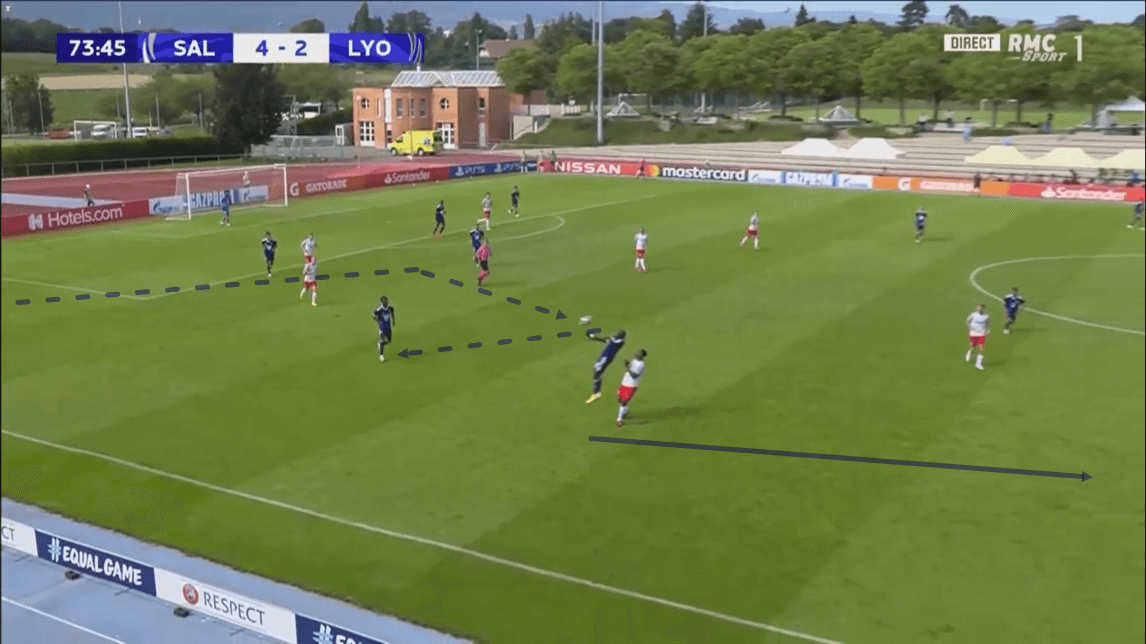
Eli Wissa was introduced to this game for Les Gones in the 50th minute of the contest and he played a pivotal role for the French side throughout the second half. As we can see in this image above, one way that he influenced the game was through his aerial presence.
Wissa helped Lyon to gain even more of an advantage over Salzburg in the air and in terms of physicality both up front and in other areas of the pitch, such as the slightly deeper area that we see him operating in here.
Just prior to this image being taken, Lyon were in possession of the ball in a deeper position, however, due to Salzburg’s effective pressing, they were struggling to build out from the back.
Wissa provided an effective solution to that problem as he dropped into this position and acted as a wide target man for Les Gones. The attacker managed to rise above the nearest opposition player and help his team to gain control of the ball before moving it on up the pitch and this also helped Lyon to effectively beat two lines of pressure.
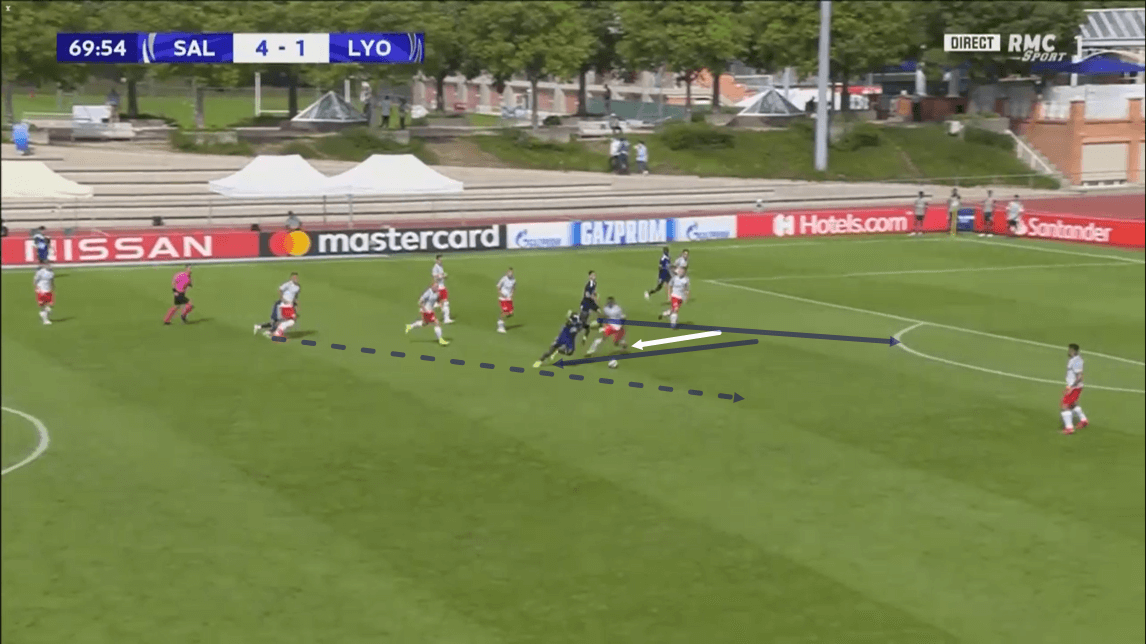
Wissa’s intelligent movement also caused problems for Salzburg. The image above shows us Wissa just after receiving possession of the ball inside the final third after dropping from his more traditional centre forward position.
We can see that as he controls the ball in this deeper position, he has attracted an opposition defender with him via his movement and this creates space for one of his teammates to continue their run and probe into that position.
As this passage of play moves on, Wissa spreads the ball out wide, finding a teammate there, who goes on to play the ball into the box, finding the Lyon player who had ran into the space created by Wissa’s movement and this results in a goal, so it’s clear that Wissa’s introduction to this match had a big impact on Lyon’s tactics and their efficiency in front of goal in the second half.
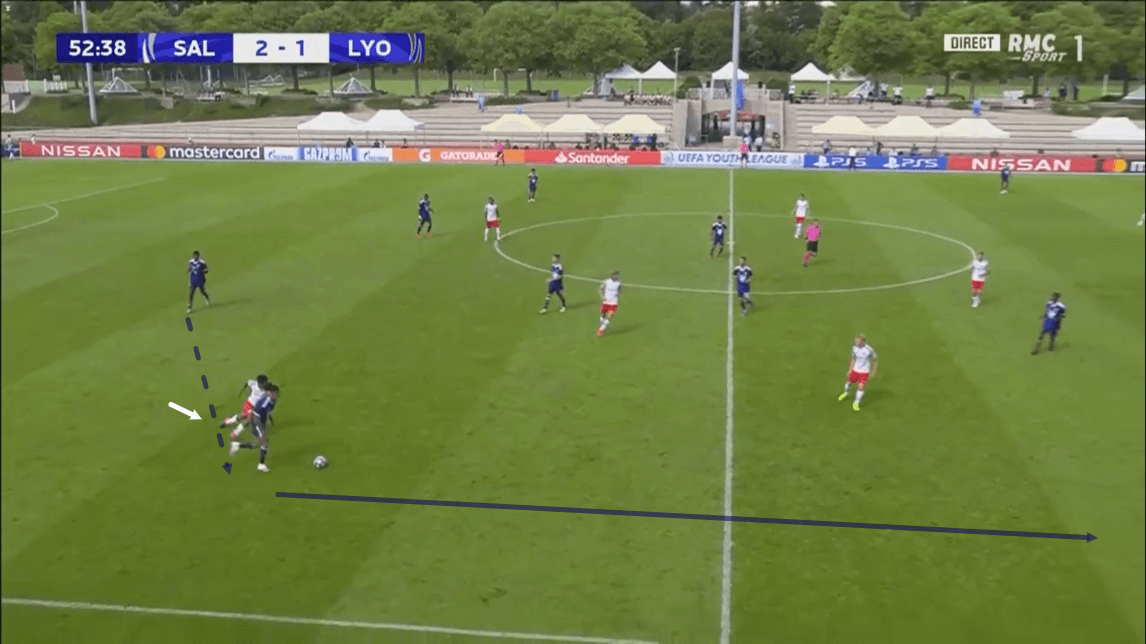
In the second half of this game, Lyon placed greater emphasis on the role of their two full-backs in the build-up. In the first half, we established that the full-backs offered a passing option to the goalkeeper and central defenders in the build-up if needed and we also explained that after receiving the ball, they then tended to play it inside to the midfield.
However, the full-backs took more responsibility for progressing the ball up the pitch themselves in the second half and we can see an example of this in action in the image above.
After collecting the ball deep, the right-back here had plenty of space in front of him, with the majority of Salzburg’s players focusing their attention on protecting the centre of the pitch. The right-back gets past the press of the near-side striker and he goes on to carry the ball forward.
This was a common theme of Lyon’s build-up throughout the second-half. They relied a lot more on their full-backs to progress the ball and exploit the space out wide. This tactic didn’t always come off for Les Gones, however, it was effective at times during the second half and the two full-backs were more than capable of performing this role to a decent standard, so this may not have been a bad tactical decision, especially when you consider that they had been struggling to play through the centre in the first half due to the quality of Salzburg’s pressing.
Red Bull Salzburg in possession
While Lyon struggled to play through the centre due to Salzburg’s pressing, the Austrian side also had difficulty playing through the centre due to the French outfit’s defensive structure and how they packed the middle of the pitch with bodies.
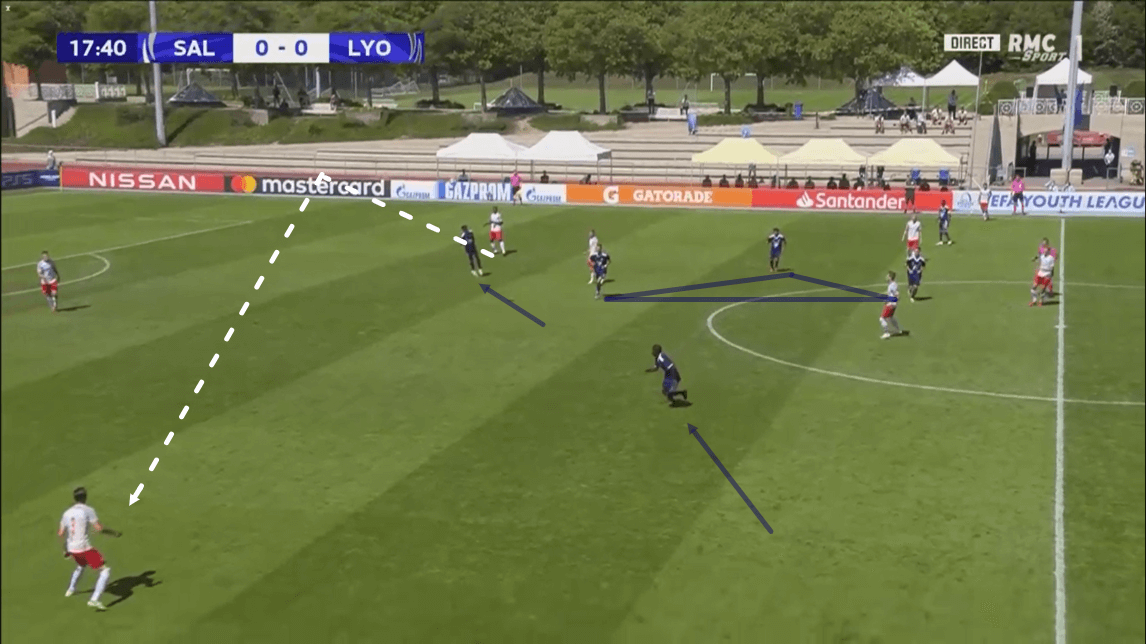
We can see an example of Salzburg attempting to deal with Lyon’s well-organised defensive structure while attempting to build out from the back in the image above. One way that Salzburg attempted to play past the opposition during the early stage of the build-up was by directly switching the play from one side of the pitch to the other via a long-ball such as the one we can see the Austrian side playing here.
Lyon’s players remained compact and stayed quite close to one another – thus making it difficult to play through them – high up the pitch as well as in deeper areas of the pitch and we can see that in the image above. However, one way that Salzburg tried to use that to their advantage in this game was by switching the play from the side of the pitch that the Lyon players were occupying over to the side of the pitch that was more free.
This required a lot of technical skill from the Salzburg players, as, without that, it would be very easy to fail at creating space by switching the play like this as it would give Lyon’s players enough time to readjust their positions if the ball was controlled poorly, however, these switches of play generally served Salzburg well during the early stages of the build-up.
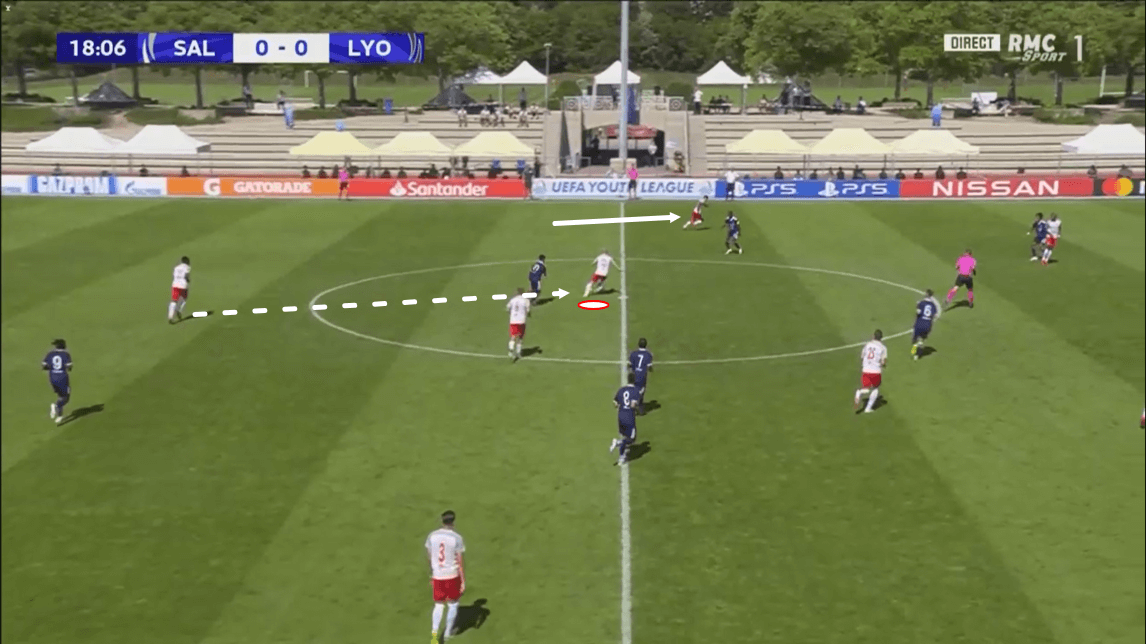
Lyon generally made it impossible for Salzburg to play through the centre of the pitch, however, on occasion, the Austrian side did manage to play the ball to their midfielders and when they did so, the role of their full-backs seemingly increased in importance.
We can see an example of the Salzburg defender finding a central midfielder in this image above and as the midfielder receives the ball and begins to turn, the left-back is already taking off down the wing. As we can see, the left-back does have plenty of space to move into on the wing and the midfielder does ultimately manage to find him and his run after carrying the ball into the opposition half.
Judging by how effective this move was, this might have been a combination that Salzburg would’ve looked to have used on more occasions had they been able to build through the centre more often than they were.
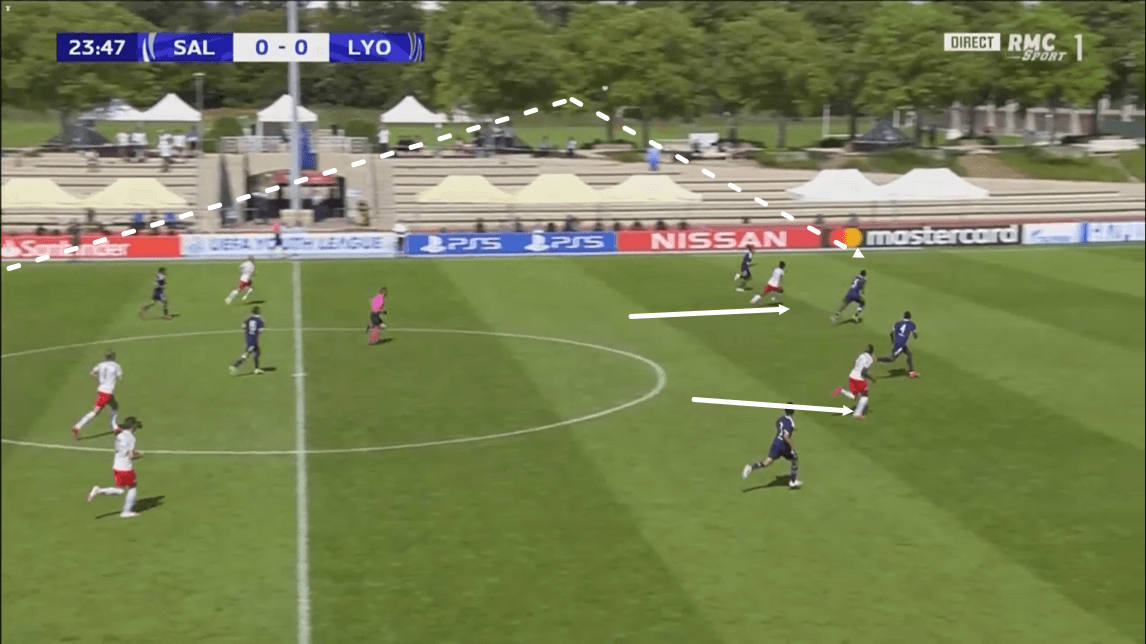
Additionally, Salzburg were also comfortable with playing the ball long from the back and exploiting their two forwards’ runs into the channels beside the central defenders and the full-backs during this game.
Salzburg’s forwards were constantly making these runs during Wednesday’s fixture and they caused Lyon a lot of problems via their runs into these channels. One of the ways that they created so many problems for Les Gones thanks to these runs, was the way in which their teammates exploited their movement via long-balls and the attackers were subsequently able to utilise their pace to get through on goal.
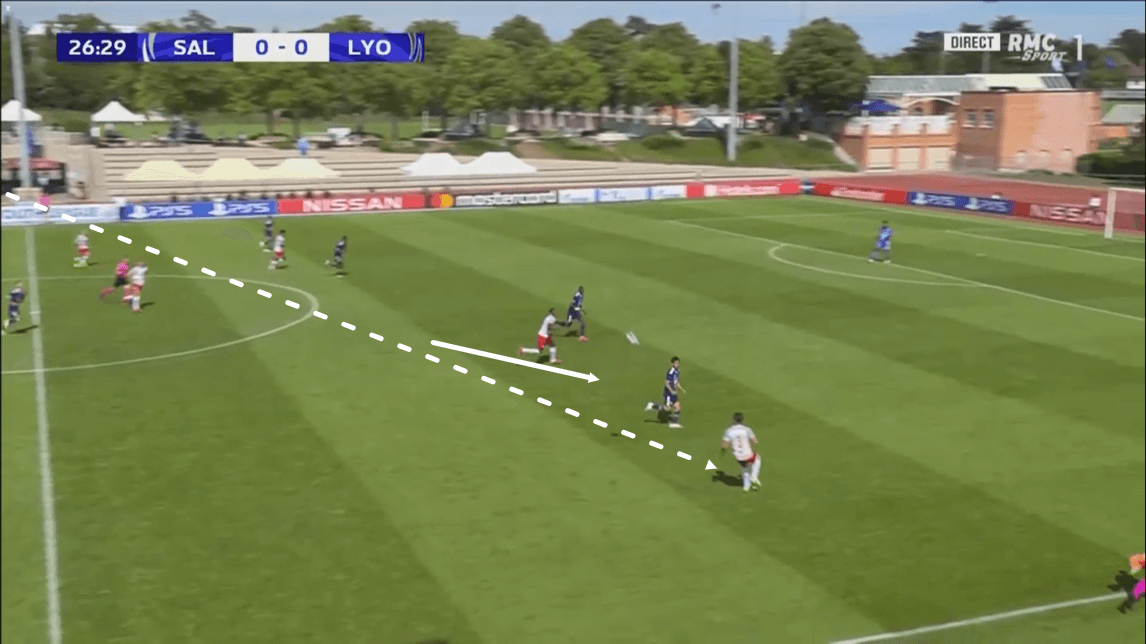
We can see another example of one of Salzburg’s switches of play from one flank to the other, as well as an example of the Austrian side’s centre forwards making their runs into these channels in this image above and this passage of play shows us another way in which Les Gones created clear-cut chances thanks to these runs in Wednesday’s game.
As the two forwards make these runs, they drag the Lyon centre-backs with them, as we can see here. However, while the defenders have to follow the runs in order to prevent the Salzburg forwards from having a clear run through on goal, they did also get dragged out of position in the process.
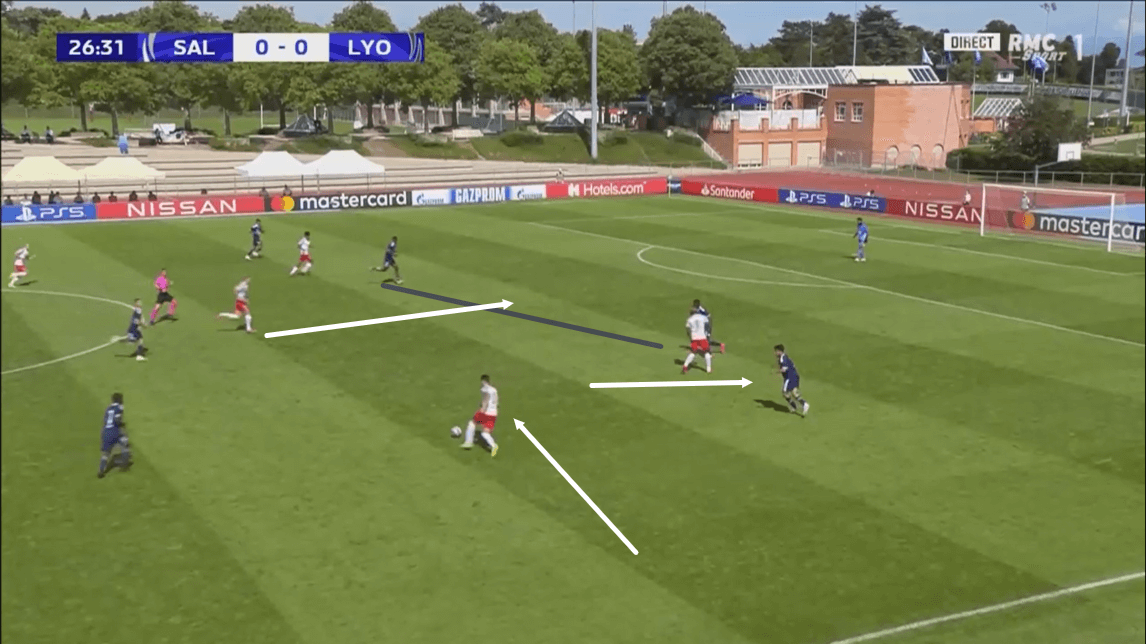
The two forwards’ runs frequently created a large gap between the two Lyon centre-backs and Salzburg exploited that space on multiple occasions by having their attacking midfielder attack the space, which we can see him doing in this image above.
Salzburg created a variety of goalscoring opportunities for the attacking midfielder, as well as their two centre forwards, in this manner throughout Wednesday’s game and this, combined with the effectiveness of these runs in getting the forwards in behind via long-balls made these runs arguably the most important element of the Austrian side’s offensive tactics in this quarter-final win.
Conclusion
To conclude this tactical analysis piece, it’s clear that both of these two teams enjoyed plenty of success in attack. Salzburg’s tactics, in terms of how their two centre forwards were utilised, as well as their high press, played a pivotal role in carving out a plethora of goalscoring opportunities for them in this fixture, while Lyon’s exploitation of Salzburg’s difficulty with coping with long-balls in behind, as well as the French side’s tactical adaptations in the second half – including the introduction of Wissa to this game – also helped them to threaten Salzburg’s goal on numerous occasions throughout this game.
In the end, Salzburg just about edged it in this one, however, both sides displayed plenty of interesting tactics in this contest.




Comments